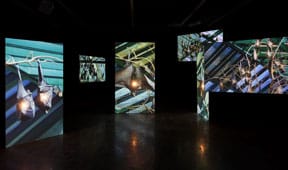Persona Ficta, Keren Gueller
Curator: Shlomit Breuer
30/01/2020 -
26/09/2020

A tiny Mexican free-tailed bat is the protagonist driving Keren Gueller’s exhibition. Detaching its taxidermied body from the permanent display in Petach Tikva’s Man and Environment Museum, she formulates a fictitious biographical plot for it, which commences with Project X-Ray and concludes with a daring escape from a test facility and settling in a bat colony in the city of Petach Tikva. “As bats fly squealing in the hollow of some great cave, when one of them has fallen out of the cluster in which they hang,”1 it is all the same, whether we are concerned with dissociation from nature; fallen out of from “the collection” which functions within a catalogued autonomous narrative; detachment from a body of knowledge in which all species have an equal status; or disconnection from an axiomatic taxonomic apparatus with methodical regulating values—any type of falling out or dissociation elicits dread.
Project X-Ray, better known as Bat Bomb Project, was conceived in the USA during World War II. It explored the possibility of releasing bats carrying small incendiary bombs over the Japanese Empire, whose activation was to set the paper and wood structures typical of Japanese architecture on fire as they landed. The Mexican free-tailed bat, weighing 14 grams, was selected for the mission. Concurrently, a miniature incendiary bomb was developed which contained napalm. The bomb’s efficacy was proven when a group of “armed” bats fled the test lab and set multiple fires in the area. In an experiment conducted in December 1943, the project was crowned a success when an especially built demo-village was burned to the ground. In 1944, development of the atomic bomb as part of the Manhattan Project was completed. In light of the more efficient and decisive alternative for the termination of the war, Project X-Ray was canceled, and the aircraft initially intended to carry the bats were adapted as vehicles for the launching of atomic bombs.
The stuffed bat, whose flat and preserved manifestation lends it the aesthetic quality of an archival readymade document, while offering a realistic illustration of the appearance and perpetuation of death, quintessentially embodies the nature-culture dichotomy, and within it—the patronizing philosophy and mastering approach to nature. Despite our familiarity with the way in which human imagination has appropriated the bat images—along the contradictory range of sensations between horror, admiration, humor, and aversion, feelings that have become rooted in myths, prejudice, as well as the fictive character of Batman in comics—the appropriation of the animal itself for the purpose of testing and research cannot but elicit disconcert.
According to John Berger, “this reduction of the animal, which has a theoretical as well as economic history, is part of the same process as that by which men have been reduced to isolated productive and consuming units. Indeed, during this period an approach to animals often prefigured an approach to man.“2 In this laconic equation, suffice it to put the Japanese kamikaze pilots on one side, and the flying bat bombs, which were developed and activated during the same historical period, on the other, to realize that both are objectified victims of the modern war industry.
Reality and representation, historical truth and fiction are the raw materials used by Gueller to construct a sculptural mise en scène that floats in a new spatial and temporal composition. Her engagement with the gap and interrelations between historical documentation of a real action and a monument as an image of memory etched in the material, introduce the ways in which the culture of memory, its representation and perpetuation are constructed, on the one hand, and the manner in which visual signifiers hidden from the public eye, including works of art (e.g. in the basements of museum collections), transform from a periodical document to a cenotaph, on the other.
Notes
1. Homer, The Odyssey, Book XXIV, in The Iliad and the Odyssey, trans. Samuel Butler (Chicago: Encyclopedia Britannica, 1955), p. 317.
2. John Berger, “Why Look at Animals?,” in About Looking (1980; New York: Vintage, 1991), p. 13.

